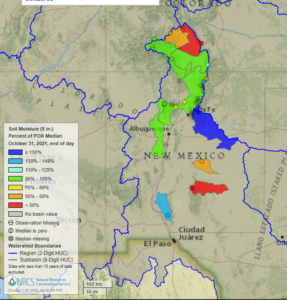Yes.
But that’s not stopping me!
The Jan. 1 forecasts, courtesy of Angus Goodbody of the NRCS, for flows at Otowi (the head of New Mexico’s Middle Rio Grande Valley) and San Marcial (the tail) are for “normal” flows, where “normal” is defined now by the median of flows from 1991-2020.
The reason it’s definitely too early to be optimistic is that it’s just January! The remaining months in the winter snow accumulation season will either be wet, or they will be dry, and that will make all the difference. As Anne Marken, Water Operations Division Manager for the Middle Rio Grande Conservancy District, explained to the district’s board at yesterday afternoon’s meeting, “There’s a lot of winter left”.
There are a couple of good signs, though.
First, soil moisture in the headwaters region is substantially better than the previous two years, when dry soils and shallow aquifers took a big cut of the snowmelt before it ever got to the rivers. This is in part a result of a better 2021 monsoon season. (Click on the picture for a link to NRCS’s cool (new?) data map thingies).
Second, it’s actually snowed. The snowpack is not great, and has been concentrated along the western edge of the basin’s upper reaches, but it’s a pretty good start.
But see Marken’s “lot of winter left” comment.
A note on the data:
For “normals” for this sort of analysis, the water management/forecast/climate community uses the mean and/or median over a 30-year window. This shifts every ten years, and for 2022 we now need to become accustomed to the 1991-2020 time window, shifted for this year’s forecasts from the 1981-2010 window we’ve been using.
In dropping the relatively wet 1980s in favor of the relatively drier teens, we’ve got a drier “normal” against which to compared.
NRCS is also shifting its normal forecasting, the numbers Goodbody publishes each month, from using the mean for the reported “normal” to the median. Statistics nerds will understand that the median better reflects the central tendency for skewed datasets like runoff, but I am not one of those people so thinking through the difference and applying it to my runoff intuitions makes my head hurt. Thankfully the NRCS’s Goodbody (I think of him as our “forecast data concierge”) shared a great new tool for comparing the two time periods and two different measures of central tendency.


Rio Grande stakeholders would also benefit from using a stress test hydrology, similar to what is being done on the Colorado River Basin, and really need to have the same level of forecast service as that at Colorado Basin River Forecast Center (CBRFC), unless something has changed over the last three years. Of note is the December unregulated inflow into Powell, which was 89% of the 30-yr average (1991-2020) but had 205% of average precipitation….. a significant loss caused by aridification.
Doug – This is (these are?) great suggestions, but all of what you’re asking has a necessary pre-condition that we lack – the riches of the Colorado River Basin water management community! Working on the Rio Grande, as I am quite a bit now, I am filled with Colorado River resource envy.
Hi John yes, it’s a matter of $$$ which has created the resources Salt Lake City has at its disposal, a reflection of the Colorado watershed’s overall wealth. The Colorado Basin stakeholders should look over the Continental Divide and monitor the Rio Grande hydrologic conditions closely and with concern, as the Rio Grande is a canary in the coal mine, so to speak, for the Colorado River system. The Rio Grande has flashier hydrology but also mirrors the Colorado River system both in water supply (snowpack in the Rockies) and demand (both urban and ag users), along with an interface with Mexico and Federal oversight below Elephant Butte Reservoir.
Don’t they have a lot of empty reservoirs to fill back up?
Had an interesting time watching the Colorado River Authority Utah webinar today during which they reviewed the ton of work being done to come up with a framework for managing the river as part of the ongoing negotiations. Certainly did an admirable job of pointing out the challenges we face. As a resident of Utah and southern Utah, specifically, I was surprised to hear so much honesty about the hydrology and Lake Powell level predictions given that rose-colored glasses have been the norm here. Certainly lots of work ahead.